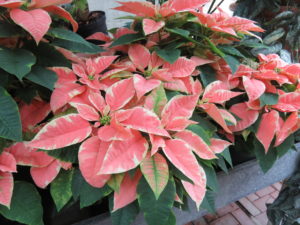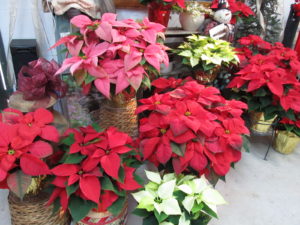The winter holidays may be over, but your poinsettia plant is likely still looking pretty. If you opt to grow and re-bloom your plant next Christmas, follow this growing schedule.
Keep the soil evenly moist and set the plant in bright daylight. Feed bi-monthly with a house plant fertilizer. Inspect and rid your plants of all pests, particularly aphids, scale, or white flies by spraying from with insecticidal soap or Neem oil.
Spring –Summer Care:
Around mid-March prune the main stem and side branches back hard to 4 – 6 inches above the soil. On warm days, move the plant outdoors into bright light but not direct sunlight. Re-pot into a larger pot, one that is at least 2 inches wider, and contains good potting media (soil). Water thoroughly and set in a sunny window. On days with outdoor temps in mid-fifties or higher, move the plant outdoors and bring it back indoors if temps drop below 55°F. Once the danger of frost outdoors has passed, set the plant outdoors in a semi- shady to partial sunny site. Sink the potted plant in your flower bed over the summer. Periodically rotate the pot every 2-3 weeks to prevent roots from growing through the bottom hole into the garden soil. Prune to maintain a uniform plant shape by pinching out the growing tips every 2-3 weeks to encourage branching (until mid- August).
Fall Care:
At the start of the fall season, as night temperatures drop below 55-60°F, bring the poinsettia indoors to a sunny window or a greenhouse. Continue to water and feed.
Poinsettia, including Thanksgiving and Christmas cactus (Schlumbergera spp.) and kalanchoe, are short-day or long-night plants. Flowers are initiated when the night (dark) period is greater than 12 hours for 10-12 continuous weeks. If the dark period is interrupted or broken, the poinsettia will not flower and will produce leaves only.
Put your poinsettia on an exact photoperiod schedule, such as at dusk (5 p.m.) every day cover with a heavy paper bag, black cloth, or set in a dark closet. During the daytime hours, let the plant receive daylight in an east- or south-facing window. Any short light interruption at night, such as turning on the light in the closet, may break the flower cycle. A streetlight outside a window may prevent flower formation.
Begin scheduling the poinsettia in late September or early October. Remember– the dark period must be 12 or more uninterrupted hours to initiate flowers. A dark period from 5 p.m. to 8 a.m. over 10-12 weeks is ideal for many folks.
By early December your poinsettia should have colorful bracts and flowers for late December holiday season.



 Posted in
Posted in 
